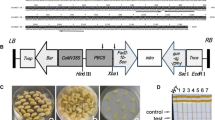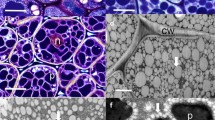Abstract
Oleosin is the most abundant protein in the oil bodies of plant seeds, playing an important role in regulating oil body formation and lipid accumulation. To investigate whether lipid accumulation in transgenic rice seeds depends on the expression level of oleosin, we introduced two soybean oleosin genes encoding 24 kDa proteins into rice under the control of an embryo-specific rice promoter REG-2. Overexpression of soybean oleosin in transgenic rice leads to an increase of seed lipid content up to 36.93 and 46.06 % higher than that of the non-transgenic control, respectively, while the overall fatty acid profiles of triacylglycerols remained unchanged. The overexpression of soybean oleosin in transgenic rice seeds resulted in more numerous and smaller oil bodies compared with wild type, suggesting that an inverse relationship exists between oil body size and the total oleosin level. The increase in lipid content is accompanied by a reduction in the accumulation of total seed protein. Our results suggest that it is possible to increase rice seed oil content for food use and for use as a low-cost feedstock for biodiesel by overexpressing oleosin in rice seeds.







Similar content being viewed by others
References
Anai T, Koga M, Tanaka H, Kinoshita T, Rahman SM, Takagi Y (2003) Improvement of rice (Oryza sativa L.) seed oil quality through introduction of a soybean microsomal omega-3 fatty acid desaturase gene. Plant Cell Rep 21:988–992
Beaudoin F, Napier JA (2000) The targeting and accumulation of ectopically expressed oleosin in non-seed tissues of Arabidopsis thaliana. Planta 210:439–445
Bhatla SC, Kaushik V, Yadav MK (2010) Use of oil bodies and oleosins in recombinant protein production and other biotechnological applications. Biotechnol Adv 28:293–300
Chuang RL, Chen JC, Chu J, Tzen JT (1996) Characterization of seed oil bodies and their surface oleosin isoforms from rice embryos. J Biochem 120:74–81
Dyer JM, Mullen RT (2008) Engineering plant oils as high-value industrial feedstocks for biorefining: the need for underpinning cell biology research. Physiol Plantarum 132:11–22
Froissard M, D’Andrea S, Boulard C, Chardot T (2009) Heterologous expression of AtClo1, a plant oil body protein, induces lipid accumulation in yeast. FEMS Yeast Res 9:428–438
Fu FF, Xue HW (2010) Coexpression analysis identifies rice starch regulator1, a rice AP2/EREBP family transcription factor, as a novel rice starch biosynthesis regulator. Plant Physiol 154:927–938
Hsieh K, Huang AH (2004) Endoplasmic reticulum, oleosins, and oils in seeds and tapetum cells. Plant Physiol 136:3427–3434
Hu Z, Wang X, Zhan G, Liu G, Hua W, Wang H (2009) Unusually large oilbodies are highly correlated with lower oil content in Brassica napus. Plant Cell Rep 28:541–549
Huang AH (1996) Oleosins and oil bodies in seeds and other organs. Plant Physiol 110:1055–1061
Huang CY, Chung CI, Lin YC, Hsing YI, Huang AH (2009) Oil bodies and oleosins in physcomitrella possess characteristics representative of early trends in evolution. Plant Physiol 150:1192–1203
Ju YH, Vali SR (2005) Rice bran oil as a potential resource for biodiesel: a review. J Sci Ind Res 64:866–882
Kitta K, Ebihara M, Iizuka T, Yoshikawa R, Isshiki K, Kawamoto S (2005) Variations in lipid content and fatty acid composition of major non-glutinous rice cultivars in Japan. J Food Compos Anal 18:269–278
Kohno-Murase J, Iwabuchi M, Endo-Kasahara S, Sugita K, Ebinuma H, Imamura J (2006) Production of trans-10, cis-12 conjugated linoleic acid in rice. Transgenic Res 15:95–100
Lardizabal K, Effertz R, Levering C, Mai J, Pedroso MC, Jury T, Aasen E, Gruys K, Bennett K (2008) Expression of Umbelopsis ramanniana DGAT2A in seed increases oil in soybean. Plant Physiol 148:89–96
Lee TTT, Chung MC, Kao YW, Wang CS, Chen LJ, Tzen JTC (2005) Specific expression of a sesame storage protein in transgenic rice bran. J Cereal Sci 41:23–29
Lu C, Fulda M, Wallis JG, Browse J (2006) A high-throughput screen for genes from castor that boost hydroxy fatty acid accumulation in seed oils of transgenic Arabidopsis. Plant J 45:847–856
Murphy DJ, Vance J (1999) Mechanisms of lipid-body formation. Trends Biochem Sci 24:109–115
Qu LQ, Takaiwa F (2004) Evaluation of tissue specificity and expression strength of rice seed component gene promoters in transgenic rice. Plant Biotechnol J 2:113–125
Qu LQ, Tada Y, Takaiwa F (2003) In situ western hybridization: a new, highly sensitive technique to detect foreign and endogenous protein distribution in rice seeds. Plant Cell Rep 22:282–285
Qu LQ, Yoshihara T, Ooyama A, Goto F, Takaiwa F (2005) Iron accumulation does not parallel the high expression level of ferritin in transgenic rice seeds. Planta 222:225–233
Qu LQ, Xing YP, Liu WX, Xu XP, Song YR (2008) Expression pattern and activity of six glutelin gene promoters in transgenic rice. J Exp Bot 59:2417–2424
Ross JHE, Sanchez J, Millan F, Murphy DJ (1993) Differential presence of olesoins in oleogenic seed and mesocarp tissues in olive (Olea europea) and avocado (Persea americana). Plant Sci 93:247–280
Sarmiento C, Ross JH, Herman E, Murphy DJ (1997) Expression and subcellular targeting of a soybean oleosin in transgenic rapeseed. Implications for the mechanism of oil-body formation in seeds. Plant J 11:783–796
Shimada TL, Hara-Nishimura I (2010) Oil-body-membrane proteins and their physiological functions in plants. Biol Pharm Bull 33:360–363
Shimada TL, Shimada T, Takahashi H, Fukao Y, Hara-Nishimura I (2008) A novel role for oleosins in freezing tolerance of oilseeds in Arabidopsis thaliana. Plant J 55:798–809
Siloto RMP, Findlay K, Lopez-Villalobos A, Yeung EC, Nykiforuk CL, Moloney MM (2006) The accumulation of oleosins determines the size of seed oilbodies in Arabidopsis. Plant Cell 18:1961–1974
Ting JT, Lee K, Ratnayake C, Platt KA, Balsamo RA, Huang AH (1996) Oleosin genes in maize kernels having diverse oil contents are constitutively expressed independent of oil contents. Size and shape of intracellular oil bodies are determined by the oleosins/oils ratio. Planta 199:158–165
Tzen JT, Lai YK, Chan KL, Huang AH (1990) Oleosin isoforms of high and low molecular weights are present in the oil bodies of diverse seed species. Plant Physiol 94:1282–1289
Tzen JT, Lie GC, Huang AH (1992) Characterization of the charged components and their topology on the surface of plant seed oil bodies. J Biol Chem 267:15626–15634
Tzen J, Cao Y, Laurent P, Ratnayake C, Huang A (1993) Lipids, proteins, and structure of seed oil bodies from diverse species. Plant Physiol 101:267–276
Wu LS, Wang LD, Chen PW, Chen LJ, Tzen JT (1998) Genomic cloning of 18 kDa oleosin and detection of triacylglycerols and oleosin isoforms in maturing rice and postgerminative seedlings. J Biochem 123:386–391
Wu YY, Chou YR, Wang CS, Tseng TH, Chen LJ, Tzen JT (2010) Different effects on triacylglycerol packaging to oil bodies in transgenic rice seeds by specifically eliminating one of their two oleosin isoforms. Plant Physiol Biochem 48:81–89
Zienkiewicz K, Castro AJ, Alche Jdé JD, Zienkiewicz A, Suárez C, Rodríguez-García MI (2010) Identification and localization of a caleosin in olive (Olea europaea L.) pollen during in vitro germination. J Exp Bot 61:1537–1546
Zullaikah S, Lai CC, Vali SR, Ju YH (2005) A two-step acid-catalyzed process for the production of biodiesel from rice bran oil. Bioresource Technol 96:1889–1896
Acknowledgments
This work was supported by the National Program of Transgenic Variety Development of China (2013ZX08001-006), National High Technology Research and Development Program (863) (2011AA100604) and the Natural Science Foundation of China (No. 31171368). The REG-2 promoter was kindly provided by Dr. F. Takaiwa, NIAS, Japan.
Author information
Authors and Affiliations
Corresponding author
Additional information
Communicated by H. Becker.
Rights and permissions
About this article
Cite this article
Liu, W.X., Liu, H.L. & Qu, L.Q. Embryo-specific expression of soybean oleosin altered oil body morphogenesis and increased lipid content in transgenic rice seeds. Theor Appl Genet 126, 2289–2297 (2013). https://doi.org/10.1007/s00122-013-2135-4
Received:
Accepted:
Published:
Issue Date:
DOI: https://doi.org/10.1007/s00122-013-2135-4




